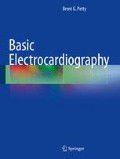Abstract
This chapter presents a systematic approach to the interpretation of electrocardiograms (EKGs). The five fundamental elements are rate, rhythm, axis, intervals, and waveform. After each of these elements is assessed, the results of the findings are synthesized into a final summary.
The chapter also describes the features of the normal tracing, including the range of normal for various elements. Having an understanding of the normal EKG can form the foundation for recognizing the deviations from normal that constitute abnormalities.
Access this chapter
Tax calculation will be finalised at checkout
Purchases are for personal use only
References
Hurst JW. Naming of the waves in the ECG, with a brief account of their genesis. Circulation. 1998;98:1937–42.
Davidowski TA, Wolf S. The QT interval during reflex cardiovascular adaptation. Circulation. 1984;69:22–5.
Bazett HC. An analysis of the time relationship of electrocardiogram. Heart. 1920;7:353.
Fridericia LS. The duration of systole in the electrocardiogram of normal subjects and of patients with heart disease. Acta Med Scand. 1920;53:469–86.
Carter EP, Andrus BC. Q-T interval in human electrocardiogram in absence of cardiac disease. JAMA. 1922;78:1922.
White PD, Mudd SG. Observation on the effect of the various factors on the duration of electrical systole of the heart as indicated by the length of the Q-T interval of the electrocardiogram. J Clin Invest. 1929;7:387–435.
Tikkanen JT, Anttonen O, Juntilla MJ, Aro AL, Kerola T, Rissanen HA, et al. Long-term outcome associated with early repolarization on electrocardiography. N Engl J Med. 2009;361:2529–37.
Haissaguere M, Derval N, Sacher F, Jesel L, Deisenhofer I, de Roy L, et al. Sudden cardiac arrest associated with early repolarization. N Engl J Med. 2008;358:2016–23.
Fuster V, Alexander RW, O’Rourke RA, editors. Hurst’s the heart. New York: McGraw-Hill; 2000.
Author information
Authors and Affiliations
Rights and permissions
Copyright information
© 2016 Springer Science+Business Media New York
About this chapter
Cite this chapter
Petty, B.G. (2016). Components of the Electrocardiogram: The Normal Tracing. In: Basic Electrocardiography. Springer, New York, NY. https://doi.org/10.1007/978-1-4939-2413-4_1
Download citation
DOI: https://doi.org/10.1007/978-1-4939-2413-4_1
Publisher Name: Springer, New York, NY
Print ISBN: 978-1-4939-2412-7
Online ISBN: 978-1-4939-2413-4
eBook Packages: MedicineMedicine (R0)

